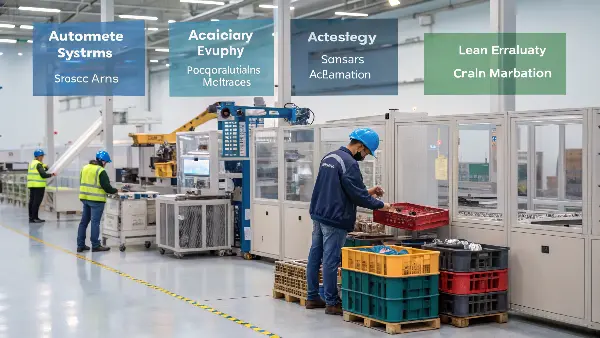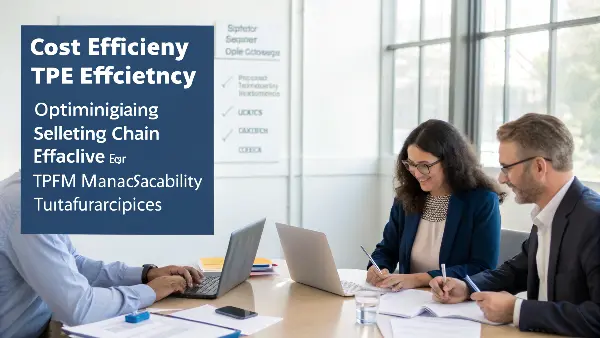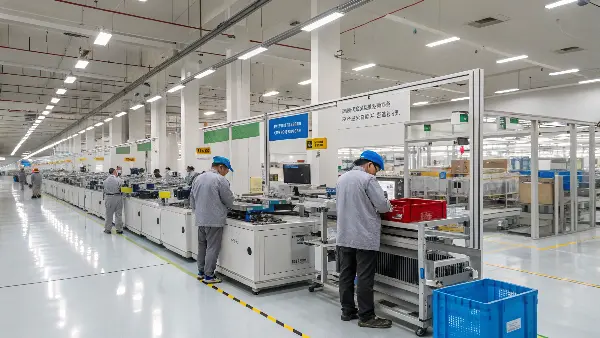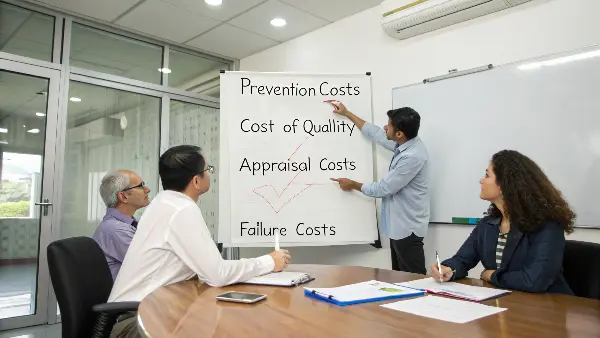Struggling with rising manufacturing costs for your TPE adult products? These increasing expenses can shrink your profits and make it difficult to stay competitive. But there’s a way to cut costs significantly by focusing on process efficiency, without ever compromising the quality your customers expect.
To achieve cost efficiency, focus on four key areas: streamlining your supply chain, optimizing the production process with lean principles, strategically implementing automation, and making smart choices in product design and materials. This holistic approach minimizes waste and maximizes value from start to finish, ensuring you get the best possible product for the lowest possible cost.

I’ve spent years in this industry, both on the manufacturing floor and as a brand partner. I’ve seen firsthand how small changes in process can lead to huge savings. It’s not about cutting corners; it’s about working smarter. Too many brand owners think that the only way to lower costs is to demand a lower price per unit, but that’s a short-sighted view that often leads to quality problems. The real, sustainable savings are found by looking at the entire process, from raw material to finished product. Let’s break down exactly how you can apply these strategies to your own brand and boost your bottom line.
What are the core strategies for achieving cost efficiency in TPE manufacturing?
Overwhelmed by all the different ways you could save money? It’s easy to get lost in the details and not know where to start. Implementing a clear, focused strategy is the only way to see real results without creating new problems or sacrificing the feel and safety of your products.
The most effective strategies involve a three-pronged attack: optimizing your supply chain for better material sourcing, choosing cost-effective TPE grades that still meet quality standards, and implementing "Design for Manufacturability" (DFM) principles early on. These foundational steps prevent costly issues before production even begins, creating savings that ripple through the entire project.

Let’s dive deeper into these core areas. True cost efficiency is built on a strong foundation, and these three pillars are where you should focus your initial efforts. Getting them right means you avoid expensive problems down the line. I once worked with a brand that was so focused on the unit price that they ignored these fundamentals. They ended up with a product that was difficult to make, used unnecessarily expensive material, and faced constant shipping delays. We had to go back to the drawing board, and by addressing these three areas, we cut their total landed cost by nearly 20%.
1. Optimize Your Supply Chain
Your supply chain is more than just shipping; it starts with raw material sourcing. For TPE, this means having a strong relationship with material suppliers. This allows for better negotiation on pricing, especially for bulk orders. But it also provides access to technical support and information on new, more cost-effective TPE formulations. We also need to think about logistics. Consolidating shipments, optimizing packaging to reduce dimensional weight, and choosing the right shipping lanes can dramatically cut transportation costs, which are a huge part of your final product cost.
2. Smart Material Selection
Not all TPE is created equal. There are dozens of grades, each with different properties of hardness, texture, and durability. A common mistake is using a premium, high-cost TPE for a product that doesn’t require its specific properties. By working closely with your manufacturer, you can identify a TPE grade that provides the perfect feel and body-safe qualities your customers expect, but at a more reasonable price point. Sometimes, a slight adjustment in formulation can maintain the desired feel while reducing material cost.
| TPE Consideration | High-Cost Impact | Cost-Saving Strategy |
|---|---|---|
| Material Grade | Using medical-grade TPE for a non-insertable product. | Match the TPE grade to the product’s actual use and safety requirements. |
| Colorants | Complex, custom colors or pearlized effects. | Stick to standard colors, which are cheaper and readily available. |
| Additives | Special additives for unique textures or scents. | Only use additives that provide a clear functional or marketing benefit. |
3. Design for Manufacturability (DFM)
This is perhaps the most critical and often overlooked strategy. DFM is the process of designing your product to be as easy and efficient to manufacture as possible. For TPE adult products, this means creating shapes that are easy to injection mold and remove from the mold. Complex undercuts or extremely thin sections can lead to high defect rates, increased labor for demolding, and slower production cycles. By simplifying a design—without sacrificing its aesthetic or function—you can reduce tooling costs, shorten cycle times, and lower the number of rejected parts. This is a conversation you should have with your manufacturer during the earliest stages of development.
How can you optimize production to make it truly cost-effective and efficient?
Does your production line feel inefficient, with unexpected delays and errors? These small problems add up quickly, costing you significant time and money. By adopting the principles of lean manufacturing, you can create a smooth, predictable, and highly cost-effective production flow that benefits both you and your manufacturer.
Ensure production is cost-effective by applying lean manufacturing principles to eliminate waste in all its forms—from excess material to wasted motion. Combine this with targeted automation for repetitive tasks. This dual approach increases throughput, improves consistency, and significantly reduces labor and material costs per unit, making your operation far more competitive.

Thinking "lean" isn’t just a trendy business term; it’s a powerful mindset for manufacturing. The core idea is simple: identify and eliminate anything that doesn’t add value for the end customer. In TPE product manufacturing, waste can hide in many places. I remember visiting a factory where the molding machine and the trimming station were on opposite sides of the room. Workers wasted hours each day just walking back and forth. By simply rearranging the workshop layout, we eliminated that wasted motion and increased their daily output by over 10%. It’s about finding these small, seemingly minor inefficiencies that, when combined, create major cost drains.
Understanding and Eliminating the 8 Wastes
Lean manufacturing provides a great framework for spotting waste, often remembered by the acronym DOWNTIME. Here’s how it applies to making TPE adult toys:
- Defects: Products with imperfections (air bubbles, seam lines, wrong color) must be scrapped or reworked, costing material and labor. Better mold design and process control reduce this.
- Overproduction: Making more products than are currently ordered creates inventory costs (storage, management) and risks obsolescence.
- Waiting: Idle time for machines or workers. This could be waiting for raw materials to arrive, for a mold to cool, or for the next step in the process.
- Non-Utilized Talent: Not using your team’s skills and insights. The machine operator often knows the process best; their feedback is invaluable for improvement.
- Transportation: Moving materials or products unnecessarily. As in my story, a poor factory layout is a primary cause.
- Inventory: Excess raw materials or finished goods tie up cash and require storage space. Just-in-Time (JIT) principles can help manage this.
- Motion: Unnecessary movement by workers, like reaching for tools, bending, or walking. An ergonomic and well-organized workstation minimizes this.
- Extra-Processing: Doing more work than necessary. For example, over-polishing a part of the product that isn’t visible or critical to function, or using packaging that is excessively complex.
The Role of Smart Automation
Automation is another key to efficient production. While a fully automated factory is unrealistic for many, targeted automation offers huge returns. For TPE products, this often means:
- Automated Injection Molding: Modern machines can control temperature, pressure, and cycle time with extreme precision, reducing defects and ensuring consistency.
- Robotic Demolding: A robotic arm can be programmed to carefully remove finished products from the mold. This is faster and more consistent than manual demolding, and it reduces the risk of damage to delicate parts.
- Automated Packaging: Simple machines can be used to place products into boxes or seal bags, freeing up workers for more value-added tasks like quality control.
By combining a lean mindset with smart automation, you create a production system that is fast, repeatable, and extremely cost-effective.
What’s a practical way to balance quality and cost in production?
Worried that cutting costs will mean lowering your quality standards? This is a common and valid fear. A race to the bottom on price can quickly destroy a brand’s reputation and customer trust. The secret isn’t just cutting costs, but investing smartly to prevent expensive failures from ever happening.
The best method is to use the "Cost of Quality" model. This means focusing your spending on ‘Prevention Costs’ (like great design and supplier vetting) and ‘Appraisal Costs’ (like good QC). This investment dramatically reduces ‘Failure Costs’ (defects, returns, rework), leading to a lower total cost of ownership and higher product quality.

The Cost of Quality is a concept I try to explain to every brand owner I work with. It’s a simple but powerful idea: every dollar spent on preventing problems is a dollar that saves you from spending ten dollars to fix problems later. I learned this lesson the hard way early in my career. We took on a project for a client who wanted to save a few hundred dollars by skipping a mold flow analysis—a computer simulation that predicts how the TPE will fill the mold. They saw it as an unnecessary "prevention" expense. The result? The final mold had filling issues, leading to thousands of dollars in scrapped parts and a two-month delay in their product launch. That small saving upfront cost them dearly.
Breaking Down the Cost of Quality
This model divides costs into two main categories: the cost of good quality and the cost of poor quality. Your goal is to shift your spending from the second category to the first.
| Cost Category | Sub-Category | Examples in TPE Manufacturing |
|---|---|---|
| Cost of Good Quality | Prevention Costs | Investing in Design for Manufacturability (DFM), creating clear quality standards, training workers, qualifying good material suppliers, preventative machine maintenance. |
| Appraisal Costs | Incoming material inspection, in-process quality checks, final product testing (e.g., durability, function), maintaining test equipment. | |
| Cost of Poor Quality | Internal Failure Costs | Scrapped products, reworking defective items, machine downtime due to process issues, time spent analyzing failures. These are costs incurred before the product leaves the factory. |
| External Failure Costs | Customer returns, warranty claims, handling customer complaints, product recalls, lost sales, and damage to your brand’s reputation. These are costs incurred after the customer receives the product. |
As you can see, the costs associated with failure, especially external failures, are massive and can threaten the viability of your business. By investing more in prevention and appraisal, you directly reduce the chances of these failures occurring. This means fewer defects, less rework, and most importantly, happier customers who receive a high-quality product every time. A well-designed process with good quality control doesn’t just produce better products; it produces them at a lower total cost.
Conclusion
Ultimately, optimizing costs in TPE adult product manufacturing is not about demanding cheaper prices. It’s about building a more intelligent and efficient process from the ground up. By focusing on smart supply chain management, lean production, and preventative quality investments, you create sustainable savings and a stronger, more profitable brand.
